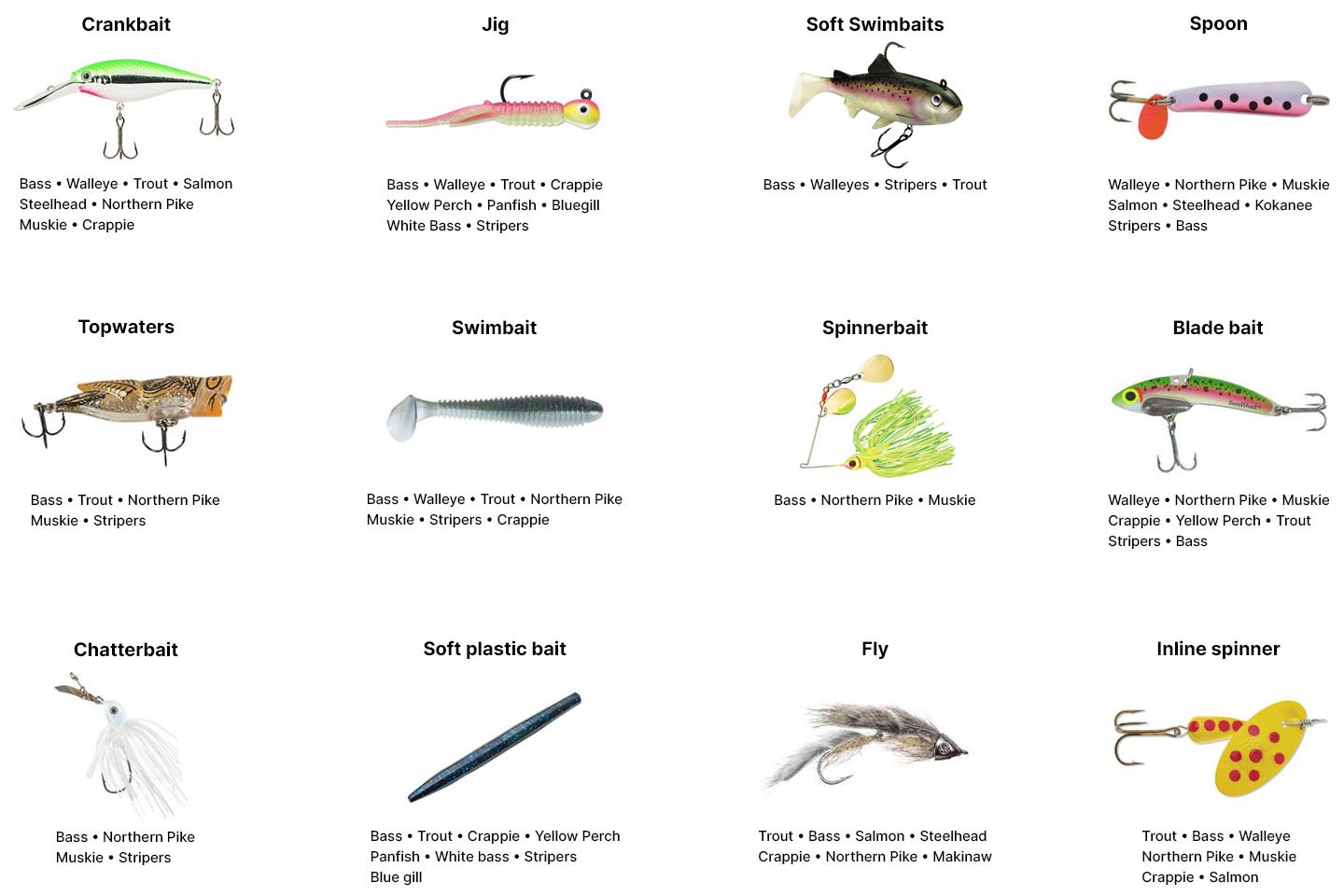Fishing is a fun hobby. It is also relaxing. Using the right lure helps catch more fish. This article will help you learn about different types of fishing lures. You will also learn how to use them.

Credit: www.amazon.com
What Are Fishing Lures?
Fishing lures are objects that look like small fish. They attract the attention of fish. Fish think the lure is food. They bite the lure, and you catch them.

Credit: www.sportsmans.com
Types of Fishing Lures
There are many types of fishing lures. Each type works best in different conditions. Here are some common types:
- Spinnerbaits
- Crankbaits
- Jigs
- Spoons
- Soft Plastics
- Topwater Lures
Spinnerbaits
Spinnerbaits have a metal blade. The blade spins when you pull the lure. This makes the lure look like a small fish. Spinnerbaits work well in muddy water. They also work well in water with lots of plants.
How to Use Spinnerbaits
- Cast the lure into the water.
- Let it sink for a few seconds.
- Reel it in slowly.
- Feel for any bites from fish.
- Set the hook if you feel a bite.
Crankbaits
Crankbaits look like small fish. They have a plastic lip. This lip makes the lure dive when you reel it in. Crankbaits work well in deep water. They also work well in open water.
How to Use Crankbaits
- Cast the lure into the water.
- Let it sink for a few seconds.
- Reel it in quickly.
- Pause for a few seconds.
- Reel it in again.
Jigs
Jigs have a lead head. They also have a tail made of hair or feathers. Jigs work well in deep water. They also work well near rocks or other structures.
How to Use Jigs
- Cast the lure into the water.
- Let it sink to the bottom.
- Lift the rod tip to make the lure jump.
- Let it sink again.
- Repeat until you feel a bite.
Spoons
Spoons are metal lures. They are shaped like a spoon. Spoons flash and wobble in the water. This makes them look like small fish. Spoons work well in open water. They also work well in deep water.
How to Use Spoons
- Cast the lure into the water.
- Let it sink for a few seconds.
- Reel it in steadily.
- Vary the speed if needed.
- Feel for any bites from fish.
Soft Plastics
Soft plastics are rubber lures. They look like worms, frogs, or small fish. Soft plastics work well in many conditions. They are very versatile.
How to Use Soft Plastics
- Cast the lure into the water.
- Let it sink for a few seconds.
- Reel it in slowly.
- Make small twitches with the rod tip.
- Feel for any bites from fish.
Topwater Lures
Topwater lures float on the surface of the water. They make noise and splash. This attracts fish from far away. Topwater lures work well in shallow water. They also work well in calm water.
How to Use Topwater Lures
- Cast the lure into the water.
- Let it sit for a few seconds.
- Reel it in slowly.
- Make small twitches with the rod tip.
- Feel for any bites from fish.
Choosing the Right Lure
Choosing the right lure can be tricky. Think about the water conditions. Also, think about the type of fish you want to catch. Here are some tips:
| Condition | Best Lure |
|---|---|
| Muddy Water | Spinnerbaits, Soft Plastics |
| Deep Water | Crankbaits, Jigs, Spoons |
| Shallow Water | Topwater Lures, Soft Plastics |
| Open Water | Crankbaits, Spoons |
| Near Structures | Jigs, Soft Plastics |
Practice Makes Perfect
Using fishing lures takes practice. Do not be afraid to try new things. The more you practice, the better you will get. Soon, you will catch more fish with ease.
Frequently Asked Questions
What Are The Main Types Of Fishing Lures?
There are three main types: soft plastics, hard baits, and jigs.
How Do Soft Plastic Lures Work?
Soft plastics mimic live bait. Their flexible design attracts fish.
What Are Hard Bait Lures?
Hard baits are solid, durable lures that resemble small fish or insects.
Why Use Jigs For Fishing?
Jigs are versatile. They work in various water depths and conditions.
Conclusion
Fishing is a great hobby. Using the right lure makes it even better. Remember to choose the right lure for the conditions. Practice using different lures. Soon, you will be catching lots of fish.





